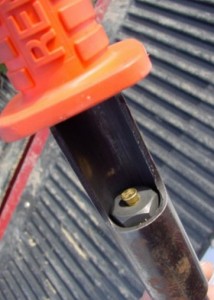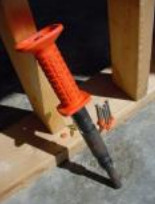 If you’ve ever worked on a commercial building site, you know that the pace of progress can be pretty fast. That’s what happens when financial rewards are tied to productivity, and it’s not entirely a bad thing. Despite sentimental reminiscences about the good old years when people worked slowly and well, it really is possible to build quickly these days while also doing a terrific job. Power tools and technologies are available that allow rapid and safe building progress along with excellent and durable results. And explosive actuated fastening tools are a case in point. Whether you’re a professional in the trades or a serious owner-builder who wants to pack more progress into each day, this under-appreciated technology is worth a closer look.
If you’ve ever worked on a commercial building site, you know that the pace of progress can be pretty fast. That’s what happens when financial rewards are tied to productivity, and it’s not entirely a bad thing. Despite sentimental reminiscences about the good old years when people worked slowly and well, it really is possible to build quickly these days while also doing a terrific job. Power tools and technologies are available that allow rapid and safe building progress along with excellent and durable results. And explosive actuated fastening tools are a case in point. Whether you’re a professional in the trades or a serious owner-builder who wants to pack more progress into each day, this under-appreciated technology is worth a closer look.
Explosive actuated fastening tools (sometimes called powder-actuated tools) use a charge of gunpowder to propel hardened metal fasteners (typically nail-like pins or threaded studs) into tough materials like concrete, stone, brick, block and even steel. The system eliminates the need to predrill fastener holes, install anchors, or wait for epoxy anchoring systems to set. But despite this speed, explosive actuated tools also provide strong results at low cost. They also happen to be a whole lot of fun, in a Clint Eastwood kind of way.
The least expensive option for getting into the game is with one of the single-shot, hammer activated models. Loading the tool involves inserting a pin into the muzzle, opening the chamber, inserting an explosive cartridge, then closing the chamber before placing the muzzle of the tool against the surface to be fastened. You’re now ready to fire the tool with a sharp hammer blow to the firing pin on the top of the handle. Firing the tool again involves manually unloading the spent cartridge case, inserting another pin into the tool, loading a new cartridge, then striking with the hammer once more. Even with this multi-step process, simple, single-shot tools like these are still much faster than any other option for hard-surface anchoring. But sometimes, when you’ve got hundreds of fasteners standing between you and the end of the day, even more speed is what you really need.
For higher output situations, take a look at semi-automatic models. These use collated fasteners and cartridges to eliminate the need to manually load and reload. You position the tool, pull the trigger, then move on and repeat the process. No hand loading necessary until you’re out of ammo. In just an hour or two you’ll accomplish more than you could in a couple of days using any other anchoring system, and the results will be trustworthy and long lasting.
Sidebar: Fastening Wood to Concrete
 One of the most common uses for explosive-actuated tools is while fastening the bottom of a wood or steel-framed wall to a concrete floor. Finishing a basement is a typical situation where you’ll run into this challenge, and explosive actuated tools are much faster than any other option. They also do an excellent job if used correctly, though there is a trick when it comes to walls. Instead of just relying on the fasteners alone, there’s reason to go beyond the basics when it comes to anchoring a wall. Although any kind of metal fastener that depends on friction to hold within masonry can do a good job long term, there’s also a possibility they can work loose in time. That’s why you should consider using construction adhesive as well as fasteners along the bottom of wall plates. Not only does this guarantee long-term solidity, but it also helps improve the sound performance of your completed wall. Even the tiniest gap underneath a wall plate can let huge amounts of sound leak from one basement room to another. A double bead of adhesive laid down in the wall location ensures best possible performance. Polyurethane construction adhesive is ideal here because it’s highly tolerant of moisture. In fact, it actually requires a little bit of moisture to cure properly. Also, to avoid cracking of concrete while using explosive actuated tools.
One of the most common uses for explosive-actuated tools is while fastening the bottom of a wood or steel-framed wall to a concrete floor. Finishing a basement is a typical situation where you’ll run into this challenge, and explosive actuated tools are much faster than any other option. They also do an excellent job if used correctly, though there is a trick when it comes to walls. Instead of just relying on the fasteners alone, there’s reason to go beyond the basics when it comes to anchoring a wall. Although any kind of metal fastener that depends on friction to hold within masonry can do a good job long term, there’s also a possibility they can work loose in time. That’s why you should consider using construction adhesive as well as fasteners along the bottom of wall plates. Not only does this guarantee long-term solidity, but it also helps improve the sound performance of your completed wall. Even the tiniest gap underneath a wall plate can let huge amounts of sound leak from one basement room to another. A double bead of adhesive laid down in the wall location ensures best possible performance. Polyurethane construction adhesive is ideal here because it’s highly tolerant of moisture. In fact, it actually requires a little bit of moisture to cure properly. Also, to avoid cracking of concrete while using explosive actuated tools.
Remember the Rule of Three’s:
- keep all fasteners at least 3 inches away from the edges of concrete slabs
- keep all fasteners at least 3 inches away from each other
- make sure slab thickness is 3 times as deep as the length of fastener penetration into the concrete.
Sidebar: Safety Rules Rule
Explosive actuated tools are safe when used correctly, but they do demand more caution than other fastening tools. Various manufacturers and jurisdictions may require training and certification before using explosive actuated tools, though all programs touch on at least these basic safety considerations:
- These tools operate like specialized firearms. Treat them with the same respect reserved for guns.
- Wear safety glasses or a face shield, a hard hat and industrial hearing protection during use.
- Brace yourself at all times when working on ladders or scaffolds to maintain good balance.
- Never point an explosive actuated tool at anyone.
- Load your tool just before use. Don’t carry loaded tools from one area of a job to another.
- Keep explosive cartridges stored in a locked box.
- Keep bystanders and other workers at least 20 feet away from tools during use.
- Be sure that your tool is unloaded before storing it.
When misfires happen (and they will), continue to hold the tool in place for 15 to 30 seconds, in case it goes off. After that, unload the defective cartridge with extreme care while continuing to point the tool as if you expect it to fire.